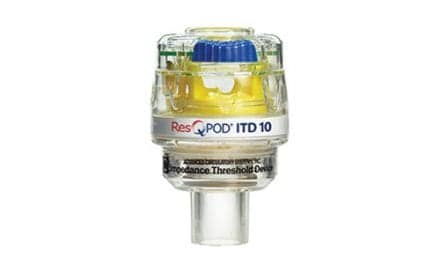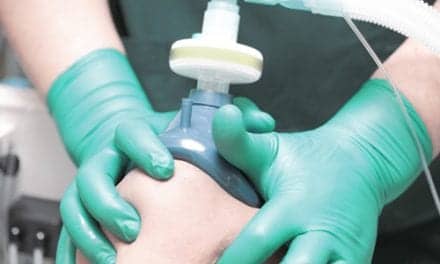Healthcare providers must consider a number of factors when considering which type of humidification and ventilation products to purchase.
Humidifiers add moisture to the atmosphere. The concept is simple: create water vapor to be absorbed into the air. The effort could be minimal: boil a lot of water, and, eureka, steam. Unfortunately, the process in healthcare must be far more precise. There are small ranges of humidity and temperature found to be ideal for most patients and maintaining these consistently over time and without complication demands more than a heating element and water.
There are a number of devices on the market today, generally falling within three categories: heated humidifiers (HHs), passive heat and moisture exchangers (HMEs), and active HMEs. Active humidifiers use external energy to heat the air being delivered, while passive devices incorporate the patient’s work as well.
The American Association for Respiratory Care (AARC) does not recommend the use of passive humidification for patients on noninvasive ventilation, but it does not make a recommendation for those on mechanical ventilation, instead offering suggested settings for both device types.1 It’s up to the care team to set institutional and individual policy.
The first decision is what type of ventilators to have available within a facility. Questions to consider include patient demographics, institutional policies, device features and performance, and, of course, budget. Fortunately, there are options. Many facilities opt to include a diverse selection to cover multiple needs.
Heated Humidifiers
Heated humidifiers use an external energy source to pass the inspiratory gas through a design that heats it using water. The device is placed in the inspiratory limb of the ventilator circuit (proximal to the ventilator).2 Air is passed through a heated water reservoir, where it takes up moisture, and through the inspiratory limb of the ventilator into the patient’s airway.
Devices fall within four design types: bubble, passover, counter-flow, and in-line vaporizers. Ashry and Modrykamien suggest that passover devices may currently be the most prevalent in use. Their research on the subject noted that bubble humidifiers have “fallen out of favor” due to their production of microaerosol, despite CDC guidelines that report the amount produced by the devices may not be clinically significant. Counter-flow and in-line vaporizer devices hold promise, but have not yet been widely studied nor adopted.2
In general, there are no contraindications to the use of HHs for either invasive or noninvasive ventilation patients, but monitoring performance is recommended. Today’s devices typically assist with this effort, using automatic water feed systems, permitting adjustment of temperature at the patient from approximately 32°C to 40°C, allowing monitoring of temperature to prevent overheating and heater failure, and providing control of the heated wire.3
The Hudson RCI Neptune Heated Humidifier with ConchaSmart Technology is one of the newest HHs from Teleflex. The device meets all the key points for invasive and noninvasive ventilation, as well as offers ease of use and adjustability, according to Kelli McGrew, MS, RRT, senior clinical specialist with Teleflex. “It provides a broad temperature and humidity range for nonventilated patients to enhance their comfort and tolerance,” said McGrew.
The temperature range for the invasive mode is guideline compliant at 32°C to 40°C; that for noninvasive mode is 28°C to 37°C. Heated high-flow cannula therapy flow rates range from 1 LPM to 60 LPM. A low-water notification feature lets users know when to replace the reservoir, and the option to select between auto settings and adjustable mode allows clinicians to optimize workflow. “Plus, the ConchaSmart technology allows the ConchaSmart Column to be used for all therapies and patient types,” said McGrew.
In general, the disadvantages to the use of HHs are minimal, related to issues such as portability and cost.3 As a result, they are often not standard equipment for patients who are expected to be ventilated for a short period of time, particularly fewer than 48 hours. Clinicians also need to be aware of the potential for reduced relative and airway obstruction and follow the manufacturers’ recommendations for use and replacement, but in general, there is little risk associated with the use of HHs.
Heat and Moisture Exchangers
The same is not true of HMEs, which do have some contraindications to use. The AARC suggests passive devices not be employed with patients receiving noninvasive ventilation, and neither passive nor active HMEs be used with ventilation patients exhibiting low tidal volumes. However, they offer advantages in areas such as portability, simplicity, and cost.
Also known as “noses,” HME devices are designed to mimic the action of the nasal cavity and are placed between the Y piece of the ventilator and the patient. They incorporate the patient’s expiratory air into the humidification process; passive devices rely on this effort alone, while active devices increase their humidification capacity with an active heated water source. Although contraindicated for some patients, active HMEs overcome the challenges that exist with HHs and passive HMEs.
Holt identifies five types of HMEs: the condenser humidifier, unsuitable for mechanical ventilation; the hygroscopic condenser humidifier; the hydrophobic condenser humidifier; hygroscopic condenser humidifier filters; and hydrophobic condenser humidifier filters. Each differs in unique ways resulting in variable efficiencies. Factors affecting humidifier efficiency include the water surface area and duration of exposure to gas as well as the temperatures of the reservoir and connective tubing (ie, the ventilator circuit).3
Contraindications are related to issues surrounding dead space, the potential for occlusion, a limited temperature range, and the need to remove the device to administer aerosols to the patient. They impact patients with thick, copious, or bloody secretions; an expired tidal volume of less than 70% of inspired tidal volume; a body temperature of less than 32°C; and a spontaneous minute volume of greater than 10 LPM.1,3
Outside of these conditions, Holt notes that use of an HME for the mechanically ventilated is an acceptable approach and may offer considerable cost savings and decreased personnel time.3 Manufacturers and research are also exploring extended use of HMEs, outside of the conventional 24-hour recommendation, which brings additional resource efficiencies.
Various studies have found the same HME could be used from 2 to 7 days with little or no contamination of the ventilator circuit, no ETT occlusion, cost savings, and decreased personnel time.2,3 Manufacturers rely on guidelines and gathered evidence to set recommendations, and some have developed devices that can be used longer than 24 hours. Teleflex’s Gibeck Humid-Flo HME can remain in-line for the first 72 hours of mechanical ventilation, even through aerosol treatments.
Advances such as these help to improve care delivery, from both a patient perspective and an administrative angle. The ability to maintain consistent humidity can have a positive effect on outcome, comfort, and cost. Many devices can deliver these features, and RTs have many options to consider before boiling a pot of water.











